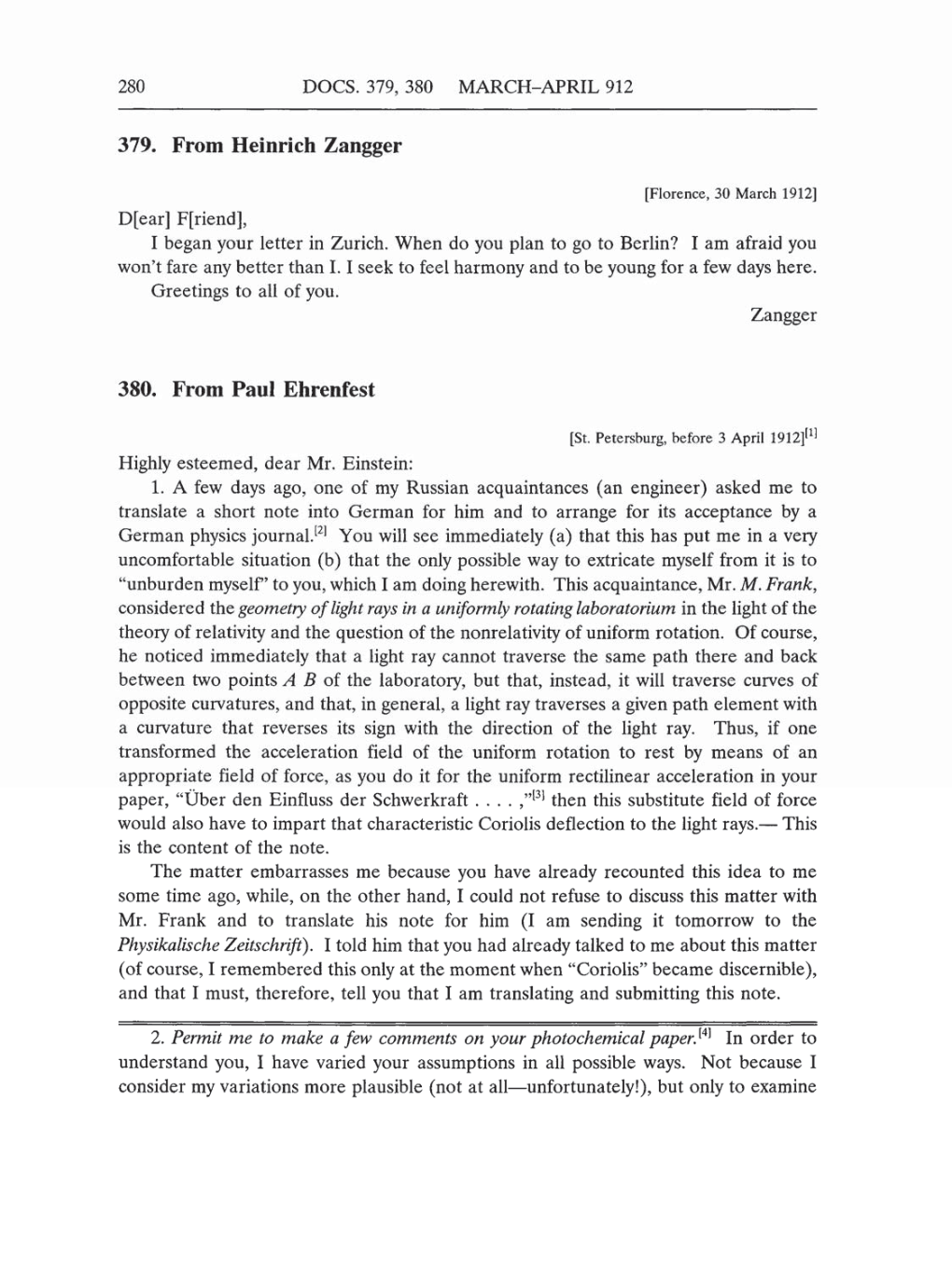280
DOCS.
379,
380
MARCH-APRIL
912
379.
From Heinrich
Zangger
[Florence,
30 March
1912]
D[ear] F[riend],
I began your
letter
in Zurich.
When
do
you
plan
to
go
to
Berlin?
I
am
afraid
you
won't fare
any
better than
I.
I
seek
to feel
harmony
and to be
young
for
a
few
days
here.
Greetings
to all
of
you.
Zangger
380.
From Paul Ehrenfest
[St.
Petersburg,
before
3 April
1912][1]
Highly
esteemed,
dear
Mr.
Einstein:
1.
A few
days ago, one
of
my
Russian
acquaintances (an engineer)
asked
me
to
translate
a
short
note
into
German
for him and to
arrange
for
its
acceptance
by
a
German
physics
journal.[2]
You will
see
immediately
(a)
that
this has
put
me
in
a very
uncomfortable situation
(b)
that the
only possible way
to
extricate
myself
from it
is
to
"unburden
myself"
to
you,
which
I
am doing
herewith.
This
acquaintance,
Mr. M.
Frank,
considered the
geometry
of
light rays
in
a
uniformly rotating
laboratorium in
the
light
of
the
theory
of
relativity
and
the
question
of the
nonrelativity
of
uniform
rotation. Of
course,
he
noticed
immediately
that
a
light ray
cannot
traverse
the
same
path
there and
back
between
two
points
A
B
of the
laboratory,
but
that, instead, it will
traverse
curves
of
opposite
curvatures,
and
that, in
general,
a
light ray
traverses
a given
path
element
with
a
curvature
that
reverses
its
sign
with
the direction of
the
light ray.
Thus,
if
one
transformed the acceleration
field of
the uniform rotation
to rest
by means
of
an
appropriate
field
of
force,
as
you
do it for
the uniform rectilinear acceleration
in
your
paper,
"Über den
Einfluss
der
Schwerkraft
....
,"[3]
then
this
substitute
field
of
force
would also have to
impart
that characteristic
Coriolis
deflection
to
the
light
rays.-
This
is
the
content
of the
note.
The
matter
embarrasses
me
because
you
have
already
recounted
this
idea
to
me
some
time
ago,
while,
on
the other
hand,
I could not
refuse
to discuss this matter with
Mr.
Frank and
to
translate
his note for him
(I
am
sending
it tomorrow to the
Physikalische Zeitschrift).
I
told him
that
you
had
already
talked
to
me
about
this matter
(of course,
I
remembered
this
only
at
the
moment
when "Coriolis" became
discernible),
and that
I
must,
therefore, tell
you
that
I
am
translating
and
submitting
this note.
2.
Permit
me
to
make
a few
comments
on
your
photochemical
paper.[4]
In
order
to
understand
you,
I have
varied
your
assumptions
in all
possible ways.
Not because
I
consider
my
variations
more
plausible (not
at all-unfortunately!),
but
only
to examine
